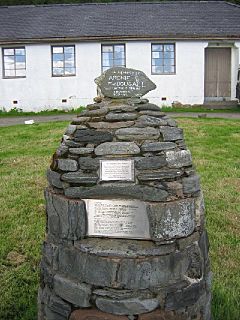Seven Men of Knoydart facts for kids
The Seven Men of Knoydart was a name given by newspapers to a group of people who tried to take over land in Knoydart, Scotland, in 1948. This name reminded people of the Seven Men of Moidart, a group who helped a Scottish prince in 1745. The Seven Men of Knoydart were all former soldiers. Their action is remembered as the last "land raid" in Scotland.
Knoydart's Past
At the end of the 1700s, about 1,000 people lived on the Knoydart peninsula. They made a living by crofting (small-scale farming) and fishing. But in 1853, many people were forced to leave. A woman named Josephine MacDonnell made about 330 people move to Canada on a ship called the Sillery. This was done to make space for sheep.
More people were forced out over the years. Landowners wanted to use the area for hunting and shooting instead of for people to live and farm.
The Land Raid of 1948
By 1948, Knoydart was owned by Lord Brocket. He was a very controversial figure. He had supported ideas that many people disagreed with before and during World War II.
On November 9, 1948, seven men decided to act. Their names were Henry MacAskill, Archie MacDonald, Archie MacDougall, Jack MacHardy, Duncan McPhail, Sandy Macphee, and William Quinnall. They started a "land raid." They used a law called the Land Settlement Act. This law allowed soldiers returning from war to take over unused land and farm it.
These men had fought in the Second World War. They had defended Britain against difficult regimes in other countries. They marked out about 65 acres (26 hectares) of farming land and 10,000 acres (4,047 hectares) of hill land where they wanted to settle.
Their raid was similar to actions taken by the Highland Land League many years before. It was also inspired by other land raids after the Great War (World War I). At that time, soldiers returning from war also drew attention to land that was not being used well.
Even though many people supported the raiders, Lord Brocket went to court. He got an order to make them leave. The government held a special meeting in 1949 to hear the men's case, but it was rejected. The men also appealed to the Secretary of State for Scotland, but they were still unsuccessful.
In 1991, a memorial stone was put up in Inverie to remember the land raid. The plaque on the stone says:
-
- Justice!
- In 1948 near this cairn the Seven Men of Knoydart staked claims to secure a place to live and work.
- For over a century Highlanders had been forced to use land raids to gain a foothold where their forebears lived. Their struggle should inspire each new generation of Scots to gain such rights by just laws.
- History will judge harshly the oppressive laws that have led to the virtual extinction of a unique culture from this beautiful place.
What Happened Next
In 1984, a property dealer named Philip Rhodes bought the estate. He started selling off parts of the land. This ended the time when owners lived far away from Knoydart. The last 17,000 acres (6,880 hectares) were bought by a company. When that company faced problems, the land was bought by the Knoydart Foundation. This was a special moment because it meant the land was bought by the local community.


